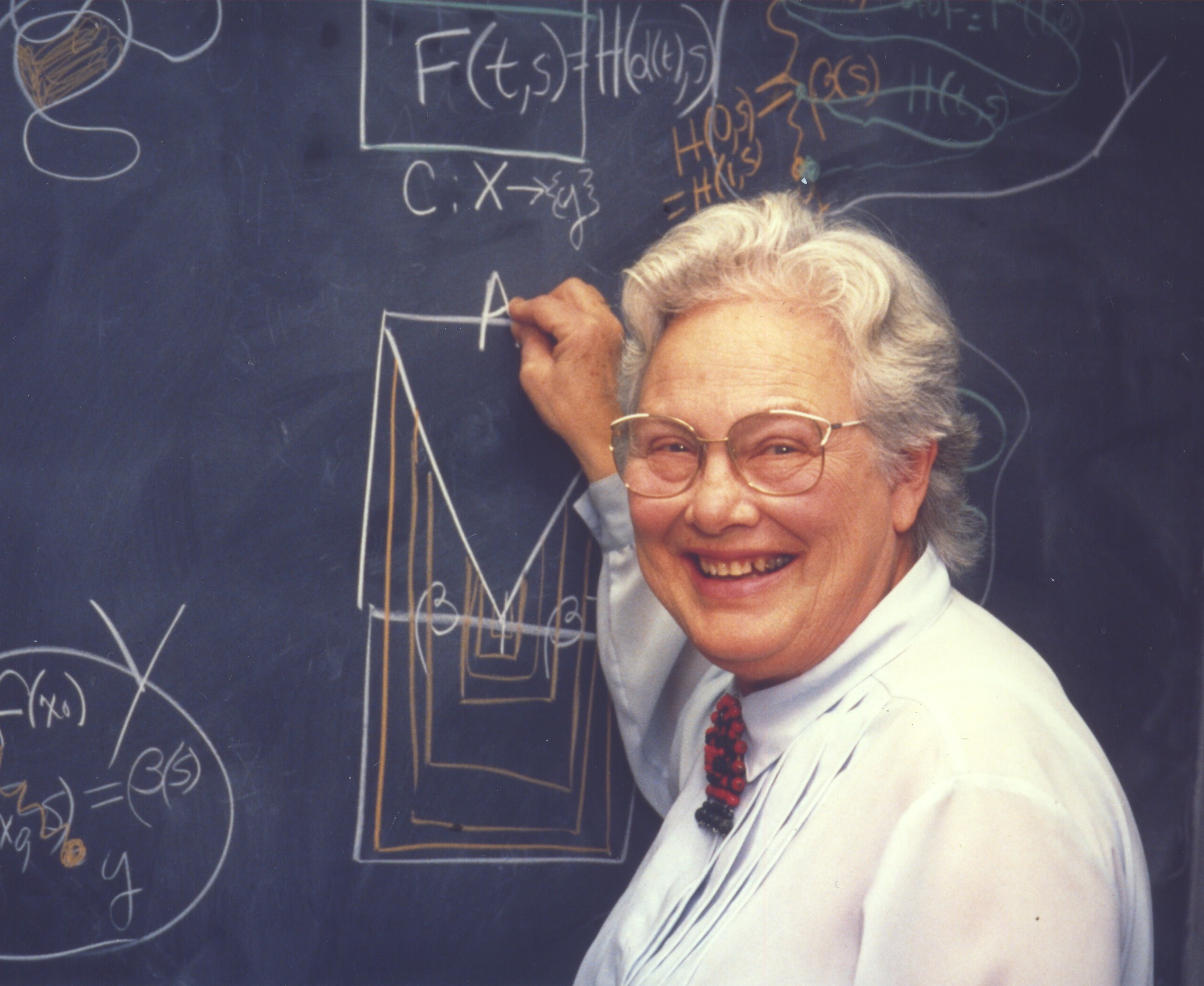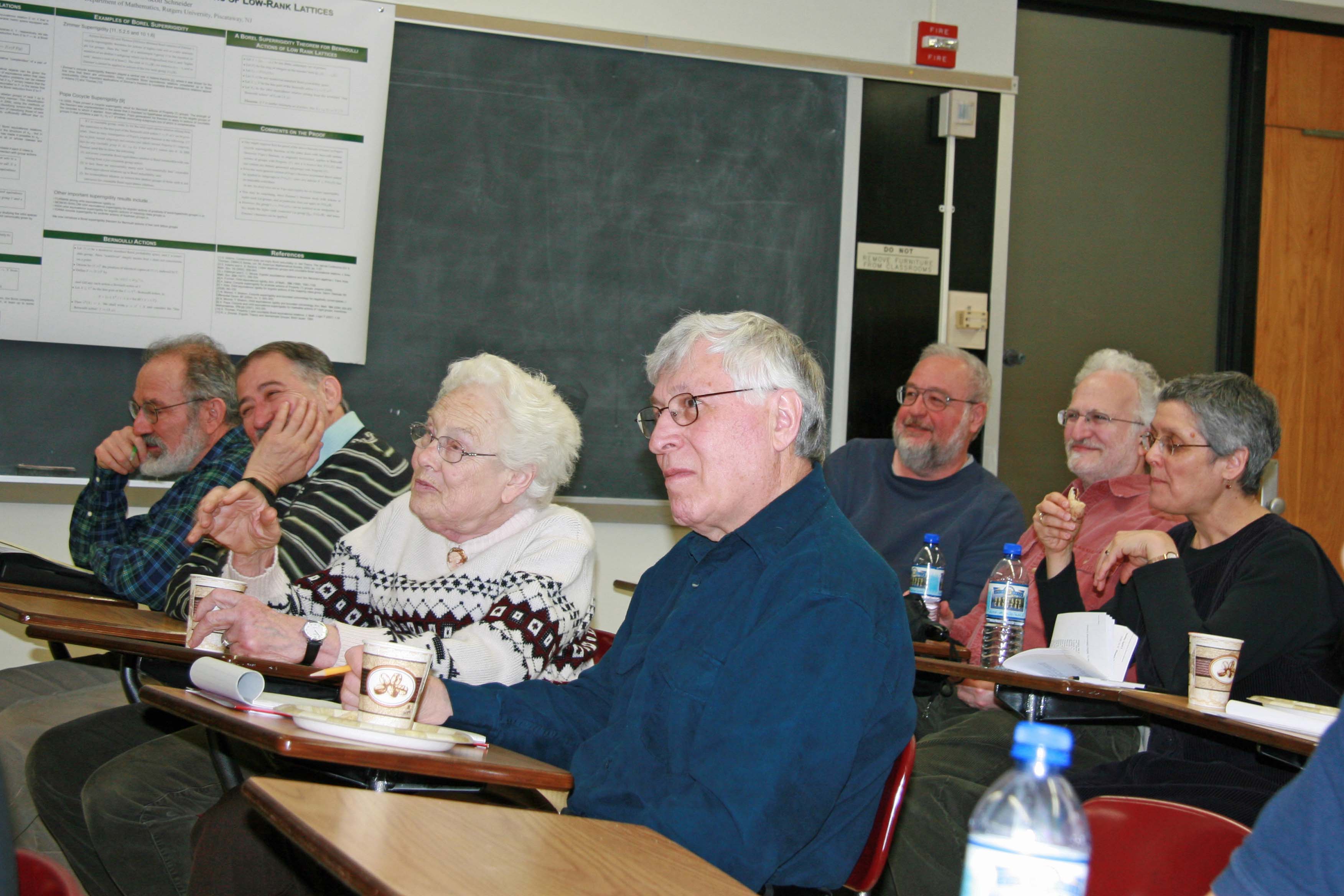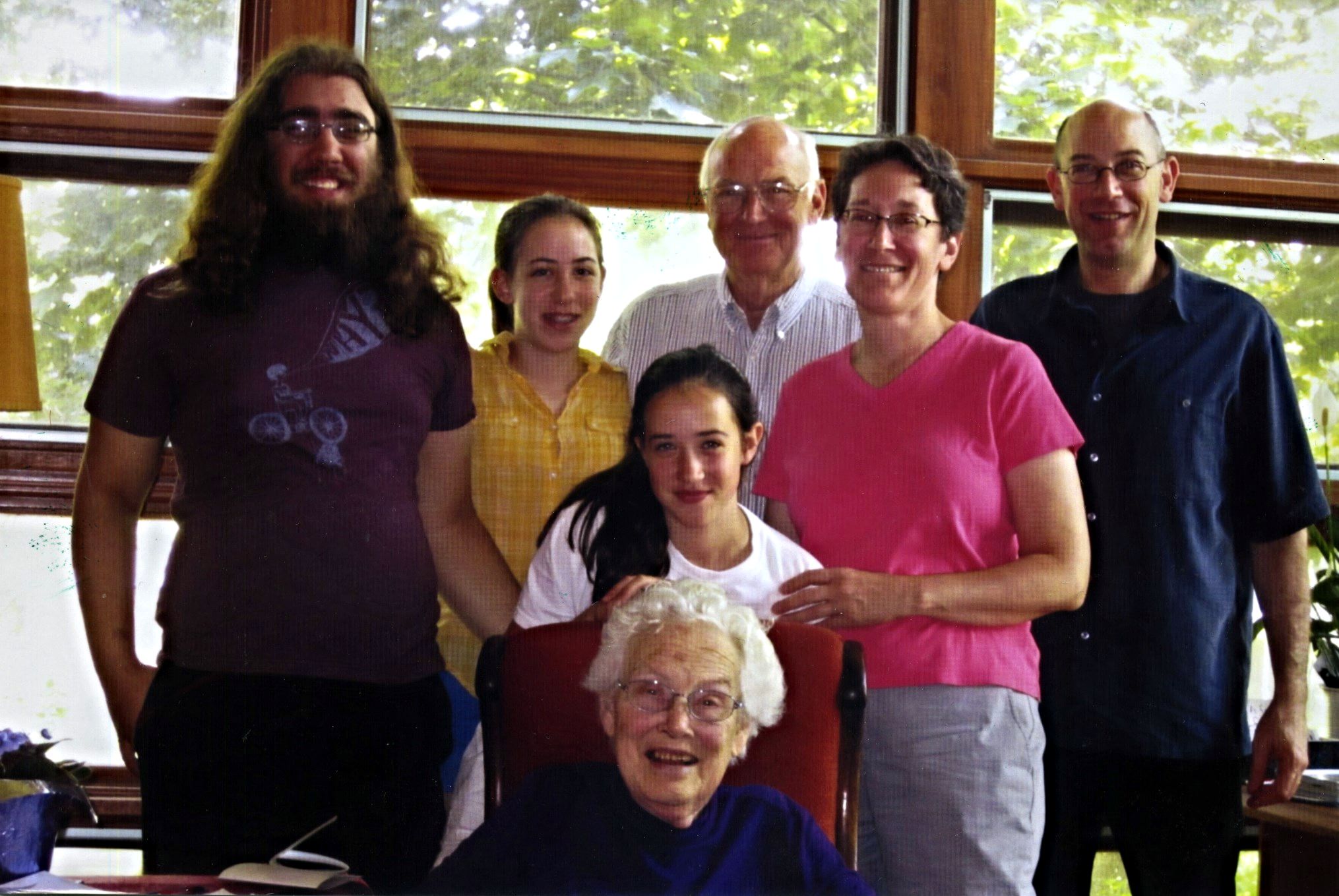by Kenneth Kunen and Arnold Miller
There is an excellent biographical interview of Mary Ellen published in [e2]. Also, there is an entire volume [e3] devoted to articles describing her mathematics. All quotations below are taken from [e3]. Mary Ellen Rudin was one of the leading topologists of our time. Besides solving a number of well-known outstanding open problems, she was a pioneer in the use of set-theoretic tools. She was one of the first to apply the independence methods of Cohen and others to produce independence results in topology. She did not do forcing arguments herself, but many of her papers make use of set-theoretic statements, such as Martin’s Axiom, Suslin’s Hypothesis, and \( \diamond \), that other researchers have shown to be true in some models of set theory and not in others.
In her thesis [1] she gave an example of a nonseparable Moore space that satisfies the countable chain condition. She published the results of her thesis in three papers in the Duke Math Journal [2], [3], [4]. To quote Steve Watson, “This cycle represents one of the greatest accomplishments in set-theoretic topology. However the mathematics in these papers is of such depth that, even forty years later, they remain impenetrable to all but the most diligent and patient of readers.”

In [5] she used a Suslin tree to construct a Dowker space. The existence of a Suslin tree is consistent with ZFC but not provable from ZFC. In [6] [8] she constructed a Dowker space just in ZFC. This space has cardinality \( (\mathfrak{N}_\omega )^{\mathfrak{N}_0} \), whereas the Suslin tree yields a Dowker space of size only \( \mathfrak{N}_1 \). Also, in 1976 [13] she showed that CH yields a Dowker space of size \( \mathfrak{N}_1 \). It is still an open question whether one can prove in ZFC that there is a Dowker space of size \( \mathfrak{N}_1 \). There is one of size \( \mathfrak{N}_{\omega+1} \) by Kojman and Shelah [e4]. Her work on Dowker spaces led to an invited address at the International Congress of Mathematicians in 1974. It also led to her interest in the box topology, because her Dowker space of size \( (\mathfrak{N}_{\omega})^{\mathfrak{N}_0} \) is a special kind of box product.
Mary Ellen is famous for her work on box products. If \( X_n \) (for \( n \in \omega \)) are topological spaces, then \( \square_n X_n \) denotes the product of the spaces \( \prod_n X_n \) using the box topology; a base for this topology is given by all sets \( \prod_n U_n \), where each \( U_n \) is open in \( X_n \). The more well-known Tychonov topology, used to prove the Tychonov Theorem (1935), requires that \( U_n = X_n \) for all but finitely many \( n \). Mary Ellen was the first person to prove anything nontrivial about box products. In [10] she showed that, assuming \( \mathrm{CH} \), \( \square_n X_n \) is normal, and in fact paracompact, whenever all the \( X_n \) are compact metric spaces. Also, her 1974 paper [11] shows that \( \square_n X_n \) is paracompact whenever all the \( X_n \) are successor ordinals; this easily generalizes to the case where the \( X_n \) are compact scattered spaces (see [e1]). It was later shown by Eric van Douwen, in ZFC, that there are always compact Hausdorff \( X_n \) for which \( \square_n X_n \) is not normal. The question of which of Mary Ellen’s positive results can be proved in \( \mathrm{ZFC} \) remains an outstanding unsolved problem in topology. Even the case where all \( X_n = \omega + 1 \) remains open, although this case (or when all \( X_n \) are compact metric) does follow from Martin’s Axiom.
Mary Ellen is also famous for her work on \( \beta \mathbb{N} \), the space of ultrafilters on the natural numbers, starting in 1966. She was coinventor of two well-known partial orders on this space: the Rudin–Keisler order and the Rudin–Frolik order. The basic properties of these are given in her 1971 paper [7], although their historic roots go back somewhat earlier.
The Rudin–Frolik order led to the first proof in ZFC that the space of nonprincipal ultrafilters, \( \mathbb{N}^\ast = \beta\mathbb{N} \backslash \mathbb{N} \), is not homogeneous. Under CH this was already known by a result of Walter Rudin (1956), who proved from CH that there is a P-point \( \mathcal{U} \in \mathbb{N}^\ast \) (that is, \( \mathcal{U} \) is in the interior of every \( G_\delta \) set containing \( \mathcal{U} \)). Nonhomogeneity follows because every infinite compactum also has a non-P-point \( \mathcal{V} \), and no homeomorphism of \( \mathbb{N}^\ast \) can move this \( \mathcal{V} \) to Walter’s \( \mathcal{U} \). It was shown much later (Shelah, in the 1970s) that one cannot prove in ZFC that these P-points exist.
For the Rudin–Frolik order, for \( \mathcal{U},\mathcal{V}\in \mathbb{N}^\ast \), say that \( U < _{\mathrm{RF}}\mathcal{V} \) iff \( \mathcal{V} \) is a \( \mathcal{U} \)-limit of some discrete \( \omega \)-sequence of points in \( \mathbb{N}^\ast \). One can show that this is a partial order; also, if \( \mathcal{U} < _{\mathrm{RF}}\mathcal{V} \), then no homeomorphism of \( \mathbb{N}^\ast \) can move \( \mathcal{V} \) to \( \mathcal{U} \), proving nonhomogeneity.

The Rudin–Keisler order comes naturally out of the notion of induced measure. If \( \mathcal{U}, \mathcal{V} \) are ultrafilters on any set \( I \), we say that \( \mathcal{U} \leq_{\mathrm{RK}}\mathcal{V} \) iff there is a map \( f : I \rightarrow I \) that induces the measure \( \mathcal{U} \) from \( \mathcal{V} \); that is, \[ \mathcal{U} = \{X \subseteq I : f^{-1} (X) \in \mathcal{V} \} .\] When \( U, \mathcal{V} \in \mathbb{N}^\ast \), \( \mathcal{U} < _{\mathrm{RF}} \mathcal{V} \) implies that \( U \leq_{\mathrm{RK}} \mathcal{V} \) and \( \mathcal{V} \nleq_{\mathrm{RK}}\mathcal{U} \). This order is of importance in model theory, in the theory of ultraproducts, since \( \mathcal{U} \leq_{\mathrm{RK}} \mathcal{V} \) yields a natural elementary embedding from \( \prod_i \mathfrak{A}_i /\mathcal{U} \) into \( \prod_i \mathfrak{A}_i /\mathcal{V} \). It is also important in the combinatorics of ultrafilters, since the Rudin–Keisler minimal elements of \( \mathbb{N}^\ast \) are precisely the Ramsey ultrafilters; such minimal elements exist under CH but not in ZFC. It is true, but not completely trivial, that neither of these two orders is a total order; that is, in ZFC there are \( \mathcal{U}, \mathcal{V} \in \mathbb{N}^\ast \) such that \( \mathcal{U} \nleq_{\mathrm{RK}} \mathcal{V} \) and \( \mathcal{V} \nleq_{\mathrm{RK}} \mathcal{U} \) (and hence also \( \mathcal{U} \nless_{\mathrm{RF}} \mathcal{V} \) and \( \mathcal{V} \nless_{\mathrm{RF}} \mathcal{U} \)). The paper [14] (1979) of Mary Ellen and Saharon Shelah gives the strongest possible result: for each infinite \( \kappa \), there is a family of \( 2^{2^\kappa} \) ultrafilters on \( \kappa \) that are pairwise incomparable in the Rudin–Keisler ordering. Mary Ellen worked extensively on the question of \( S \)- and \( L \)-spaces. She produced the first \( S \)-space (a hereditarily separable space that is not hereditarily Lindelöf) assuming the existence of a Suslin tree in 1972 [9]. Her Dowker space constructed from CH (see above) is also an \( S \)-space. Her 1975 monograph [12] devotes an entire chapter to \( S \)- and \( L \)-spaces. To quote Stevo Todorčević, “The terms ‘\( S \)-space’ and ‘\( L \)-space,’ which are predominant in most of the literature on this subject, are also first found in these lectures. This shows a great influence not only of [12] but also of M. E. Rudin’s personality on the generation of mathematicians working in this area, since it is rather unusual in mathematics to talk about certain statements in terms of their counterexamples.”
In 1999, almost a decade after her retirement, Mary Ellen settled a long-standing conjecture in set-theoretic topology by showing that every monotonically normal compact space is the continuous image of a linearly ordered compact space. This paper [15] was the final one in a series of five which gradually settled more and more special cases of the final result. The construction of the linearly ordered compact space is extraordinarily complex, and to this date there is no simpler proof known.

Mary Ellen was by consensus a dominant figure in general topology. Her results are difficult, deep, original, and important. The connections she found between topology and logic attracted many set-theorists and logicians to topology. The best general topologists and set-theorists in the world passed regularly through Madison to visit her and work with her and her students and colleagues.
She had eighteen PhD students, many of whom went on to have sterling careers of their own. To quote one of them, Michael Starbird, “From the perspective of a graduate student and collaborator, her most remarkable feature is the flood of ideas that is constantly bursting from her…. It is easy to use the Mary Ellen Rudin model to become a great advisor. The first step is to have an endless number of great ideas. Then merely give them totally generously to your students to develop and learn from. It is really quite simple. For Mary Ellen Rudin.”